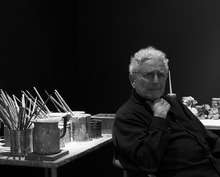Irving Petlin
Irving Petlin (December 17, 1934 – September 1, 2018) was an American artist and painter renowned for his mastery of the pastel medium and collaborations with other artists (including Mark di Suvero and Leon Golub) and for his work in the "series form"[1] in which he employed the raw materials of pastel, oil paint and unprimed linen, and found inspiration in the work of writers and poets including Primo Levi, Bruno Schulz, Paul Celan, Michael Palmer and Edmond Jabès.[2]
Irving Petlin | |
|---|---|
 Irving Petlin at Kent Fine Art, New York, 2015 | |
| Born | December 17, 1934 Chicago, Illinois, U.S. |
| Died | September 1, 2018 (aged 83) Martha's Vineyard, Massachusetts, U.S. |
| Nationality | American |
| Education | Art Institute of Chicago 1953-1956. Yale University, MFA, 1960 |
| Known for | Painting, Pastel |
| Movement | Chicago Imagist |
Petlin attended the Art Institute of Chicago from 1953-1956 where he received his BFA during the height of the Chicago Imagist movement. At a critical juncture Petlin attended Yale to study under Josef Albers, subsequently earning his MFA in 1960.[2] In 1964, his work was shown at the Hanover Gallery in London and Galerie du Dragon in Paris, where he influenced the Nouvelle figuration movement. That same year, Petlin was invited to teach at UCLA as a visiting artist, along with artists Richard Diebenkorn and Llyn Foulkes.
While in California, he was a principal organizer of the "Artist’s Protest movement against the war in Vietnam." In open meetings held at the Dwan Gallery, of which John Weber was the director, he founded the Artists’ Protest Committee. In 1966, Petlin planned the Peace Tower with help of Mark di Suvero, as well as Philip Lieder, Craig Kauffman, Larry Bell, Walter Hopps, Rolf Nelson, Judy Chicago, Lloyd Hamrol, Hardy Hanson, Eric Orr, Tanya Nuefeld, and others. "The Artists’ Call" for the tower is published in four languages, and works arrive from all over the world to be attached to it. The finished tower, was dedicated by Susan Sontag and ultimately attacked overnight. The following year, in 1965, Petlin had his first major one-man exhibition held at the Palais des Beaux Arts in Brussels. Shortly thereafter, he returned to New York City with his family and moved into an apartment on West 11th Street. At this time, his growing commitment to the American milieu resulted in the completion of the painting The Burning of Los Angeles. During this period, Petlin Was a founder and a participant in Artists and Writers Against the War in Vietnam. He also toom part in the Art Workers Coalition, the Art Strike, the Moratorium and the Venice Biennale.
.jpg)
The Burning of Los Angeles (1965–1967)
(Collection of the Fine Arts Museums of San Francisco)
From the 1960s, when he became one of the founding members of "Artists and Writers Against the War in Vietnam," Petlin was a leader in political activism by visual artists. He created the iconic anti-Vietnam War poster And babies in 1969. Petlin continued his militant interventions after the 1960s through such activities as his participation in the "Artists' Call Against the U.S. Intervention in Central America".[3] Petlin taught at the University of California, Los Angeles, the Cooper Union in New York, as well as the Pennsylvania Academy of the Fine Arts in Philadelphia. He lived in Paris, New York and Martha's Vineyard, Massachusetts.
Petlin died of liver cancer in Martha's Vineyard, Massachusetts on September 1, 2018 at the age of 83.[4]
Selected exhibitions
|
|
References
- Palmer, Michael. Active Boundaries: Selected Essays and Talks. New York: New Directions Publishing, 2008. p. 164
- "Irving Petlin: A retrospective". Absolutearts.com. 2010-01-29. Retrieved 2014-06-02.
- International School of Painting, Drawing, and Sculpture in Umbria, Italy Archived November 12, 2009, at the Wayback Machine
- "Irving Petlin, Artist Who Recorded Injustice, Dies at 83". The New York Times. September 7, 2018.
- http://www.kentfineart.net
- http://www.pierrejoris.com/blog/?p=13753
External links
- Petlin sites and artist pages
- Irving Petlin Artist Page
- Irving Petlin: A Retrospective Artist Page at Jan Krugier Gallery website
- Irving Petlin on artnet
- Others on Petlin, including reviews & perspectives
- "Irving Petlin: The Committed Brushstroke by Peter Selz.
- Irving Petlin, Este Mundo by Carrie Moyer at The Brooklyn Rail
- from Nomadics Blog: 3 Irving Petlin Shows in New York poet Pierre Joris provides links and commentary on his blog to the 3 major Petlin shows that occurred in New York City in early 2010
- Press: Three essays on Petlin link provides access to free PDF online versions of seminal Petlin retrospectives by Edward Fry (from the Wiesswald exhibition catalogue), Paul Cummings ("The Precincts of Light"), and Michael Palmer ("A Bonfire in the Starry Night")
- The Unbearable Yet Obligatory, And other shows of modern and contemporary works
- Studio Matters, Arts & Commentary: Irving Petlin’s paintings; Bernardo Siciliano’s girlie pix; a Leonardo da Vinci for Times Square by Maureen Mullarkey
- Petlin in his own words
- Kent Gallery Exhibition Catalogue of Major Paintings, 1979-2009 Click here for free PDF online publication of 90 pages that documented in full those works included in the Kent Gallery exhibition from 2010, including Petlin's own commentaries and complete biographical information on the artist
- 1000 words: Peace Tower; Irving Petlin, Mark di Suvero, and Rirkrit Tiravanija revisit The Artists' Tower of Protest, 1966 includes extensive transcript of Petlin in his own words
- Irving Petlin at Kent 2010 on YouTube Petlin discusses some of his work as he walks around the Kent Gallery in 2010
- In Conversation: Irving Petlin with John Yau renowned poet/art critic & Art Editor for The Brooklyn Rail John Yau interviews Petlin in 2006